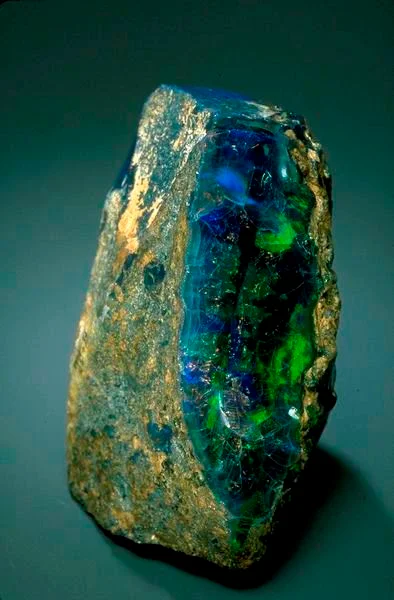Rare Huge Green-blue Opal Found in Nevada
The Roebling Opal is an extraordinary piece of opal rough, weighing a remarkable 2,585 carats. It is the largest unpolished black opal in the world and is renowned for its vibrant play of color, showcasing flashes of blue and green against its dark, inky background. Discovered in Virgin Valley, Nevada, in 1917, this exceptional gem was later donated to the Smithsonian National Museum of Natural History in 1926 by John A. Roebling, a distinguished engineer and philanthropist.
Although extremely beautiful, opal from this locality is not commonly used in jewelry because it tends to craize, or crack. Opals with a vivid play-of-color and a black or other dark body color are called black opals. The Roebling Opal is a black opal with flashes of blue and green play-of-color.
 |
| Rare Huge Green-blue Opal Found in Nevada. Image credit: Chip Clark |
Discovery and Journey to the Smithsonian
The opal's journey to the Smithsonian began with its discovery by miners working in the Rainbow Ridge Mine. Initially, the opal's value was not recognized, and it was nearly discarded. However, a keen-eyed miner recognized its potential and brought it to the attention of the mine superintendent. Realizing its significance, the superintendent arranged for the opal to be sent to New York City for examination by experts.
Upon examination, the opal's true value was revealed, and it was promptly acquired by the Tiffany & Co. jewelry firm. Tiffany & Co. exhibited the opal at the American Gem and Pearl Society's annual meeting, where it captivated the attention of John A. Roebling. Intrigued by the opal's beauty and rarity, Roebling acquired it and later donated it to the Smithsonian, ensuring its preservation and public appreciation.
 |
| Image credit: Chip Clark |
 |
| Image credit: Chip Clark |
See also: Dig Your Own Unique Opals From Nevada








%20(1).webp)